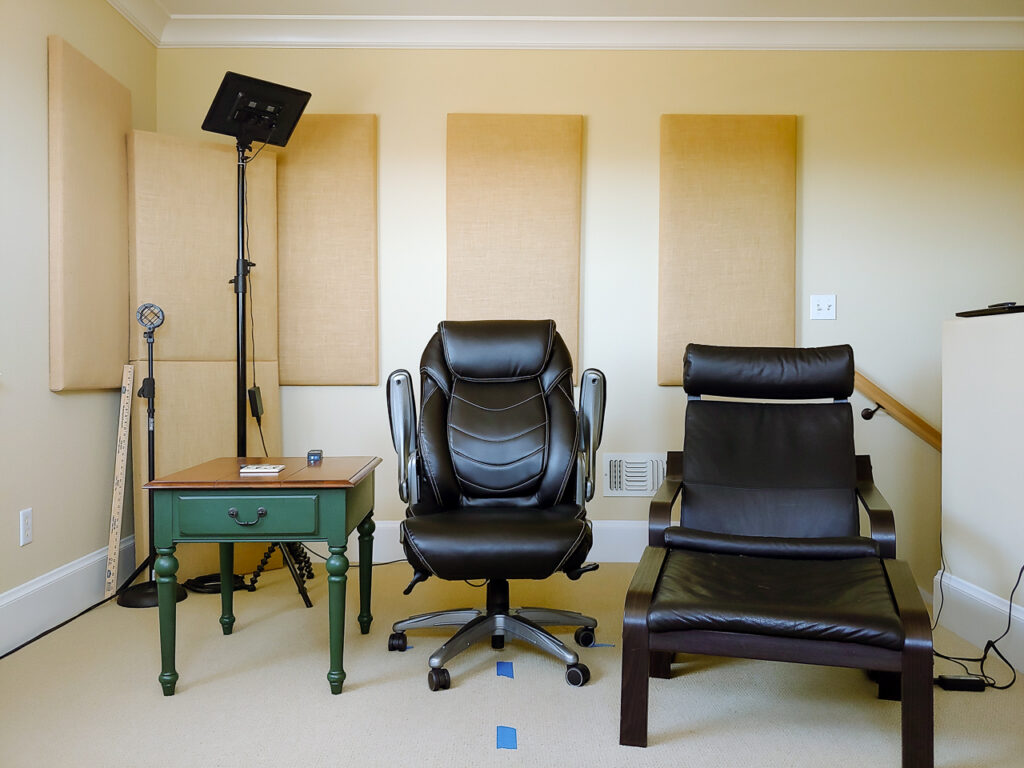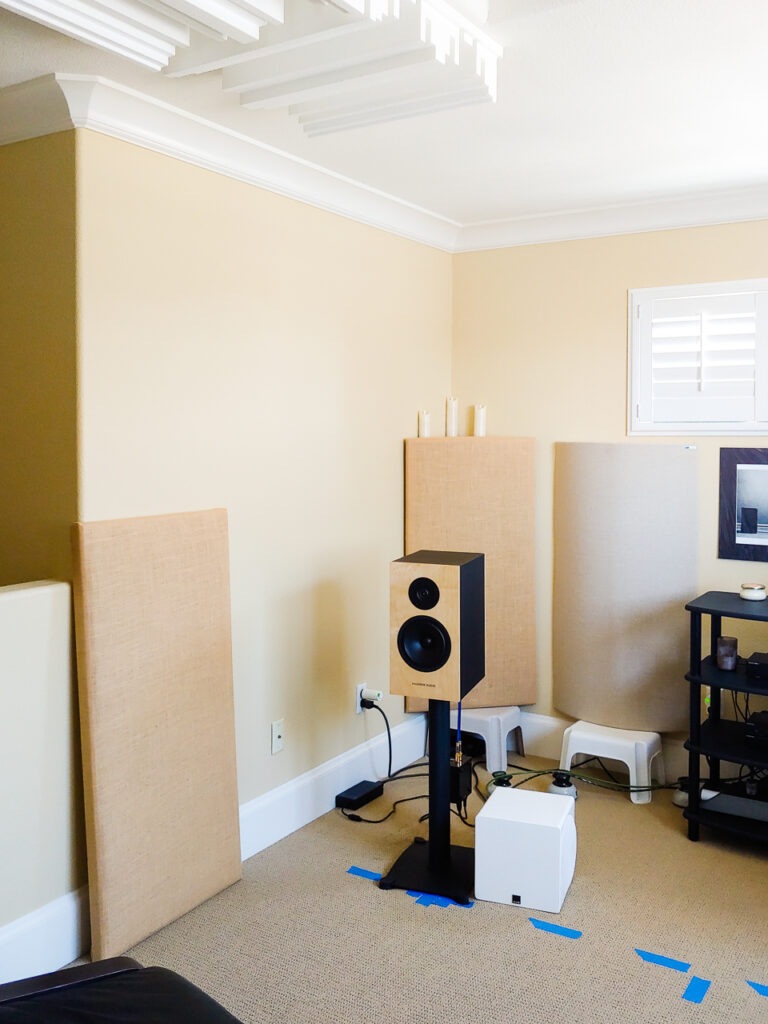This is a continuation of my review and notes as I work through Paul McGowan’s book, Audiophile’s Guide: The Stereo – Unlock the Secrets to Great Sound. Here’s a link to the start of this series. I completed all of the listening position and speaker placement tuning in part 3. Later in his book, Paul touches on room treatments, cables, and clean power. I generally agree with his recommendations, so there really was not much to change in my room along those lines. In this post, I’ll describe what I’ve done in these areas and why.
Next Level Room Tuning
With the basics sorted, Paul digs into more advanced topics that I would generally describe as listening system hygiene.
Room Treatments
When I first moved speakers into the Loft, it was a pretty echoey place. I could tell just by the sound of my voice and when clapping my hands. It’s not a large room, but as a dedicated listening space, it was never going to be filled with the furnishings you’d find in a typical living room. I measured an RT60 that was north of 700ms. If you are familiar with RT60, it’s really more useful for larger rooms. In a 15.5 ft x 10.1 ft room, 700ms is a lot of reverberation. To solve this, I went over to ATS Acoustics and used their free analysis service to estimate what I’d need to get things under control. They recommended ten 24x48x2 panels, but I felt like I should use some of that budget for bass traps. I ended up going with seven of the panels, two 24×48 corner traps, and two 24x36x4 bass traps. These brought the RT60 down to around 300ms, so a somewhat dramatic improvement. The room now sounds very natural, neither over nor underdamped.

I later added a set of QRD13 diffusers from GIK Acoustics (GIK GridFusor©) at roughly the first reflection points on the ceiling. These seem to have added a little extra spaciousness to the room. Finally, I’ve installed GIK’s PolyFusor© product on the wall behind the speakers, but honestly, I’ve neither measured nor heard much of a difference. Still, they look nice enough, so I’ve kept them. You’ve probably noticed these products in the photos I’ve shared. Most of the panels are on the wall behind the listening position, but I also have a pair of absorbers on the side walls at the first reflection points. I’ve placed a mirror at their locations and verified that the tweeters are dead-center when looking from the listening position.

The scenario that Paul describes in his book is for a multipurpose living room rather than one dedicated to 2-channel listening. A typical living room will likely not require this level of treatment because there will be more furniture, decorations, plants, books, etc., to make the room comfortable. However, if you have concerns about your environment or are just curious, I’d suggest using REW (Room EQ Wizard) to do an RT60 measurement before spending hundreds or thousands of dollars on room treatments.
Cables
Paul points out that cables can be a contentious topic. The first rule of connecting cables is that they “do not enhance sound–they only make it worse.” But, if you’re building a system from components, you’re going to need at least a few, so try to minimize the damage. He suggests listening to several alternatives with an open mind to find the combination that delivers “musical truth more than flashy sound effects.” Unfortunately, there are no test tracks or exercises to help you sort things out, but the chapter on “How to Listen” helps build the skills necessary to make these judgments.
It’s easy to end up spending too much on cables over time. If you have a system that you’re happy with and just want to elevate performance a bit, upgrading cables is a tempting road to take. Unfortunately, after a decade or two of cable upgrades, I’ve known people who have ended up investing three times as much in cables as they have in components! Of course, no one would set out to build such a system, but this level of imbalance can happen over time. To avoid this trap, I try to limit my total investment in cables to 10-20% of the system cost.
Most of my cables are from Straight Wire. They have been an OEM supplier for other brands for a long time but also market relatively high-value products under their own name. Over the years, I’ve developed a relationship with Jerry Willsie at Straight Wire. He has an uncanny ability to recommend optimal cables for any system, in some cases talking me out of going for a more expensive model in favor of one that’s a better fit. I’ve learned to trust his insight and advice as my system evolves, and he has never let me down.
Power
Of course, PS Audio offers power-related products, including high-end power regenerators. Paul asserts that “Simply plugging your stereo directly into the wall socket will never be as good as what you can accomplish with modern AC power technology.” I’m a little skeptical since modern audio equipment seems to do a great job of internally filtering and regulating power. Perhaps this was more of an issue with older vacuum tube components.
That said, I have deployed several relatively inexpensive power products in my system for peace of mind. These are from iFi Audio and employ their proprietary Active Noise Cancellation® technology, which works like noise-canceling headphones. Essentially, they play noise back onto the line after inverting the phase. I don’t know for sure, but PS Audio’s own Noise Harvester may employ a similar technique internally. This approach makes more sense to me than transformers and passive filters. Is it actually necessary or beneficial? I think so, but my investment is low enough that I don’t really mind if the benefits are minimal. I’m using the iFi Audio PowerStation, several AC iPurifiers, and a GroundHog+ cable to ensure that my Raspberry Pi 4 VitOS transport has a path to ground.
Measurements
Paul wraps up his book with a discussion on how measurements aid the pursuit of quality playback…how they can help us understand performance but do not always correlate directly to listening engagement and experience. I tend to agree. The topic brings my series of posts full circle and introduces what I’ll cover in the next post. When I began my journey with Paul’s book, I said that I wanted to “gain proficiency at tuning the room by ear using familiar reference tracks.” I feel like I’ve done that, but I also recognize limitations to what I can achieve by ear alone. This is especially true as it pertains to subwoofer integration. My hearing is not sufficiently acute at low frequencies, nor is my aural memory reliable for judging the many tuning parameters settings available on modern subs—more on this in the next post.
In summary, I learned a lot by working through Audiophile’s Guide: The Stereo – Unlock the Secrets to Great Sound and using The Audiophile Reference disc. Are you serious about realizing the full potential of the gear you own now or planning to purchase? If so, Paul’s book is an excellent guide that will deliver many times its purchase price in listening engagement and enjoyment. Thanks, Paul.